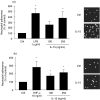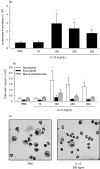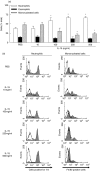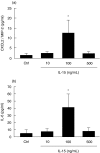Interleukin-15 increases neutrophil adhesion onto human respiratory epithelial A549 cells and attracts neutrophils in vivo
- PMID: 15996196
- PMCID: PMC1809435
- DOI: 10.1111/j.1365-2249.2005.02861.x
Interleukin-15 increases neutrophil adhesion onto human respiratory epithelial A549 cells and attracts neutrophils in vivo
Abstract
Interleukin-15 (IL-15) is a neutrophil agonist that plays a role in inflammatory disorders, including a variety of pulmonary diseases. Adhesion of neutrophils onto pulmonary cells is a major event leading to development of inflammation. Recently, elevated levels of IL-15 have been associated with different pulmonary diseases. There is no clear evidence that IL-15 modulates cell surface expression of adhesion molecules in neutrophils, or that IL-15 is involved in neutrophil adhesion onto pulmonary cells. Also, it is not clear if IL-15 induces a neutrophilic inflammation in vivo. This study was aimed at elucidation of these issues. Neutrophils were treated with IL-15 and cell surface expression of CD11a, CD11b, CD11c and CD18 was monitored by flow cytometry. The human respiratory epithelial A549 cell line was used as a substrate for the neutrophil adhesion assay and cell surface expression of CD50, CD54 and CD106 was monitored in IL-15-induced A549 cells. The murine air pouch model was used for investigating potential neutrophilic inflammation induced by IL-15 in vivo. IL-15 significantly increased neutrophil cell surface expression of CD11b and CD18 and up-regulated A549 cell surface expression of CD54. Moreover, A549 cells were found to express IL-15R components and adhesion of neutrophils onto A549 cells was increased when neutrophils or A549 cells were treated with IL-15. Finally, IL-15 induced neutrophilic inflammation in vivo and concentrations of IL-6 and CXCL2/MIP-2 were increased in IL-15-induced pouches. IL-15 might participate in inflammatory pulmonary diseases by attracting neutrophils, modulating cell surface expression molecules and increasing neutrophil adhesion onto pulmonary cells.
Figures







Similar articles
-
IL-4 increases human endothelial cell adhesiveness for T cells but not for neutrophils.J Immunol. 1990 Apr 15;144(8):3060-5. J Immunol. 1990. PMID: 1969883
-
Selective down-regulation of neutrophil Mac-1 in endotoxemic hepatic microcirculation via IL-10.J Immunol. 2009 Dec 1;183(11):7557-68. doi: 10.4049/jimmunol.0901786. Epub 2009 Nov 16. J Immunol. 2009. PMID: 19917697
-
Migration of polymorphonuclear leucocytes is influenced by dendritic cells.Immunology. 2005 Mar;114(3):375-85. doi: 10.1111/j.1365-2567.2005.02104.x. Immunology. 2005. PMID: 15720439 Free PMC article.
-
Neutrophils and neutrophil-endothelial cell adhesion in adult respiratory distress syndrome.New Horiz. 1993 Nov;1(4):631-7. New Horiz. 1993. PMID: 7916259 Review.
-
Neutrophil emigration in the lungs.Nihon Kyobu Shikkan Gakkai Zasshi. 1996 Dec;34 Suppl:141-5. Nihon Kyobu Shikkan Gakkai Zasshi. 1996. PMID: 9216204 Review.
Cited by
-
Activation of human neutrophils by Esenbeckia leiocarpa: comparison between the crude hydroalcoholic extract (CHE) and an alkaloid (Alk) fraction.J Inflamm (Lond). 2012 May 28;9(1):19. doi: 10.1186/1476-9255-9-19. J Inflamm (Lond). 2012. PMID: 22640922 Free PMC article.
-
Cytokine profile during latent and slowly progressive primary tuberculosis: a possible role for interleukin-15 in mediating clinical disease.Clin Exp Immunol. 2006 Jan;143(1):180-92. doi: 10.1111/j.1365-2249.2005.02976.x. Clin Exp Immunol. 2006. PMID: 16367949 Free PMC article.
-
Using the air pouch model for assessing in vivo inflammatory activity of nanoparticles.Int J Nanomedicine. 2014 Feb 24;9:1105-7. doi: 10.2147/IJN.S59636. eCollection 2014. Int J Nanomedicine. 2014. PMID: 24591831 Free PMC article. No abstract available.
-
Subcellular expression pattern and role of IL-15 in pneumococci induced lung epithelial apoptosis.Histochem Cell Biol. 2008 Jul;130(1):165-76. doi: 10.1007/s00418-008-0414-y. Epub 2008 Mar 26. Histochem Cell Biol. 2008. PMID: 18365236
-
Bioactive Antimicrobial Peptides as Therapeutics for Corneal Wounds and Infections.Adv Wound Care (New Rochelle). 2017 Jun 1;6(6):175-190. doi: 10.1089/wound.2016.0713. Adv Wound Care (New Rochelle). 2017. PMID: 28616359 Free PMC article. Review.
References
-
- Bamford RN, Battiata AP, Burton JD, Sharma H, Waldmann TA. Interleukin (IL) 15/IL-T production by the adult T-cell leukemia cell line HuT-102 is associated with a human T-cell lymphotrophic virus type I region /IL-15 fusion message that lacks many upstream AUGs that normally attenuates IL-15 mRNA translation. Proc Natl Acad Sci USA. 1996;93:2897–902. - PMC - PubMed
-
- Gaggero A, Azzarone B, Andrei C, et al. Differential intracellular trafficking, secretion and endosomal localization of two IL-15 isoforms. Eur J Immunol. 1999;29:1265–74. April. - PubMed
-
- Bamford RN, DeFilippis AP, Azimi N, Kurys G, Waldmann TA. The 5′ untranslated region, signal peptide, and the coding sequence of the carboxyl terminus of IL-15 participate in its multifaceted translational control. J Immunol. 1998;160:4418–26. - PubMed
Publication types
MeSH terms
Substances
LinkOut - more resources
Full Text Sources
Research Materials

